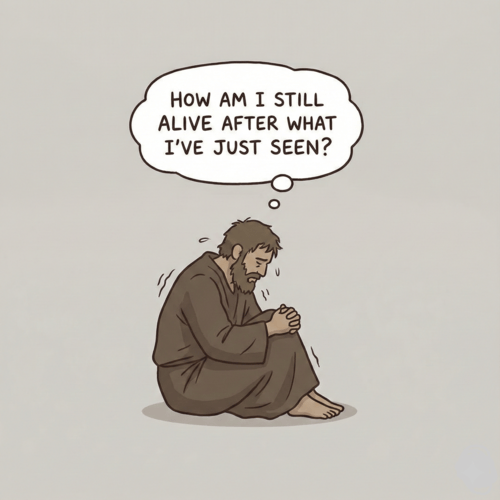How Many Times Did the Rooster Crow at Peter’s Denial?
THE CHALLENGE
When sceptics want to undermine Scripture’s reliability, they often point to Peter’s denial as Exhibit A for supposed Bible contradictions. The issue seems straightforward: Mark 14:30 records Jesus saying, “Before the rooster crows twice, you will deny me three times,” while Matthew 26:34, Luke 22:34, and John 13:38 all record, “Before the rooster crows, you will deny me three times.”
So how many times did the rooster crow at Peter’s denial? Once or twice? Critics claim the gospel writers can’t keep their story straight, casting doubt on Scripture’s trustworthiness. But is this really a contradiction, or have we misunderstood what happened that dark night in Jerusalem?
ROOSTER CROW AT PETER’S DENIAL: WHY THIS MATTERS
For those committed to Scripture’s complete truthfulness, this isn’t just an academic puzzle—it strikes at the heart of Scripture’s authority. If we can’t trust the Bible on minor details, how can we trust it on matters of eternal significance? The Reformed tradition has always maintained Scripture is both divinely inspired and historically accurate. When faced with apparent discrepancies, our response should be careful investigation, not quick concession to error.
THE SOLUTION: MARK’S PRECISION VS. GENERAL REFERENCE
The best harmonisation recognises Mark as providing the most precise account, while the other gospels use conventional language. Here’s what likely happened:
Mark, probably drawing from Peter’s own vivid memories, records Jesus’ exact words with stunning specificity. Jesus predicted Peter would deny him three times between two distinct rooster crows. The other gospel writers, focusing on the threefold denial rather than the precise timing, used the common expression “before the rooster crows”—much like we might say “before dawn” without specifying exactly which pre-dawn event we mean.
Anyone familiar with roosters knows they don’t crow just once at daybreak. They crow multiple times, often with brief pauses between distinct crowing periods. Ancient people understood “cockcrowing” as a time period (the third watch of the night, from midnight to 3 AM) rather than a single sound. Multiple roosters throughout Jerusalem would have created overlapping sounds during this period.
Jesus’ prediction was fulfilled exactly: Peter denied Christ three times between the first rooster crow and the second distinct crowing period that followed.
THE EVIDENCE SUPPORTS HARMONY
Several factors support the harmonisation. Mark’s gospel consistently provides the most detailed account of the passion narrative, likely because it draws heavily from Peter’s own testimony. Early church tradition strongly links Mark’s gospel to Peter’s preaching. The other gospel writers focus their attention on the threefold denial itself, not the specific timing markers.
Culturally, ancient audiences would have immediately understood natural rooster behaviour and the conventional use of “cockcrowing” as a time reference. The Roman military divided the night into watches, with the third watch specifically called “cockcrowing.” Multiple roosters in a city like Jerusalem would create complex overlapping sounds that ancient ears easily distinguished.
Most importantly, all four gospels agree on every essential detail: Jesus’ prediction, Peter’s three denials, the rooster crow that triggered Peter’s memory, and his immediate, bitter remorse. The differences reflect the gospel writers’ distinct emphases and selection of details, not contradictory accounts.
ROOSTER CROW AT PETER’S DENIAL: ANSWERING THE SCEPTICS
When critics say this explanation requires too much effort, they miss the point. Careful biblical study isn’t “special pleading”—it’s faithful scholarship. We approach Scripture with the same rigorous attention to detail we’d give any historical document, but with the added confidence that God has preserved His Word accurately.
The question isn’t whether we should expect minor errors in Scripture, but whether we trust God to communicate truthfully through human authors. The Reformed tradition maintains that divine inspiration doesn’t erase human personality and perspective, but it does ensure complete reliability. God worked through each gospel writer’s unique vantage point to provide a full, accurate picture of Christ’s passion.
MOVING FORWARD WITH CONFIDENCE
Rather than avoiding challenging passages, Reformed Christians engage them thoughtfully. Careful Bible study isn’t just academic exercise—it’s worship, honouring God by taking His Word seriously. When we trust Scripture’s accuracy in detailed historical accounts, we strengthen our confidence in its spiritual promises.
The rooster crow accounts remind us God’s Word can withstand scrutiny. The same precision that recorded Peter’s denials records Christ’s promises of forgiveness, resurrection, and eternal life. If we can trust Scripture’s historical details, we can certainly trust its gospel declarations.
ROOSTER CROW AT PETER’S DENIAL: QUICK REFERENCE
- Mark 14:30 “Truly, I say to you, this very night, before the rooster crows twice, you will deny me three times.”
- Matthew 26:34 “Truly, I say to you, this very night, before the rooster crows, you will deny me three times.”
- Luke 22:34 “I tell you, Peter, the rooster will not crow this day, until you deny three times that you know me.”
- John 13:38 “Will you lay down your life for me? Truly, truly, I say to you, the rooster will not crow till you have denied me three times.”
The harmony: Mark records Jesus’ most precise prediction (two crows), while the others use the conventional expression for the same time period. All accounts prove perfectly accurate when properly understood.
ROOSTER CROW AT PETER’S DENIAL: RELATED FAQs
Why would Mark include the detail about two rooster crows if it wasn’t important? Mark consistently provides the most vivid and specific details throughout his gospel, likely reflecting Peter’s own eyewitness testimony. The detail about the two rooster crows emphasises the precision of Jesus’ prophecy and the painful accuracy with which it was fulfilled. For Peter, who lived through the moment, every detail would, no doubt, have been seared into his memory.
- Doesn’t the harmonisation make Jesus’ prediction less miraculous since roosters naturally crow multiple times? Actually, it makes the prediction more miraculous, not less. Jesus didn’t just predict Peter would deny Him before some general time period—He predicted the exact sequence of events down to the specific timing between distinct rooster crows. This level of precision demonstrates supernatural foreknowledge of exact circumstances.
- Are there any early manuscripts that might resolve this differently? The manuscript evidence strongly supports the traditional reading, with Mark consistently including “twice” in the earliest and most reliable manuscripts. Some later manuscripts omit “twice” in Mark 14:30, but these appear to be attempts to harmonise rather than preserve the original text. The harder reading (Mark’s “twice”) is almost certainly original.
How do we know Mark was really drawing from Peter’s testimony? Early church fathers including Papias (60-130 AD), Irenaeus, and Clement of Alexandria consistently testified Mark’s gospel preserved Peter’s preaching. The vivid, eyewitness details throughout Mark’s passion narrative—including specific time markers, emotional reactions, and precise dialogue—support this early tradition.
- What about Jesus’ other detailed predictions that seem to vary between gospels? This same principle applies throughout the gospels: different writers often record different levels of detail from the same event. Jesus likely made multiple predictions about His passion, each with varying specificity depending on the audience and timing. The gospel writers selected details that served their particular theological emphases.
Why didn’t the other gospel writers feel the need to include the “twice” detail? Matthew, Luke, and John focused on the significance of the threefold denial itself rather than the precise timing. Their audiences would have understood “before the rooster crows” as a conventional time reference. Mark’s inclusion of “twice” serves his gospel’s emphasis on vivid, specific detail that brings readers into Peter’s experience.
How should this approach to harmonisation affect how I read other difficult passages? Begin with the assumption Scripture is accurate and that apparent contradictions often reflect our incomplete understanding rather than actual errors. Look for complementary rather than contradictory information, consider cultural and historical context, and remember that different authors had different purposes and audiences. Careful study typically reveals harmony rather than contradiction.
ROOSTER CROW AT PETER’S DENIAL: OUR RELATED POSTS
Editor's Pick

The Throne-Room Vision: Who Did Isaiah See?
The scene is unforgettable: Isaiah stands in the temple, and suddenly the veil between heaven and earth tears open. He [...]

The Angel of the Lord: Can We Be Certain It Was Christ All Along?
Throughout the Old Testament, a mysterious figure appears: the Angel of the LORD. He speaks as God, bears God’s name, [...]
SUPPORT US:
Feel the Holy Spirit's gentle nudge to partner with us?
Donate Online:
Account Name: TRUTHS TO DIE FOR FOUNDATION
Account Number: 10243565459
Bank IFSC: IDFB0043391
Bank Name: IDFC FIRST BANK






